Elephants at Sea?
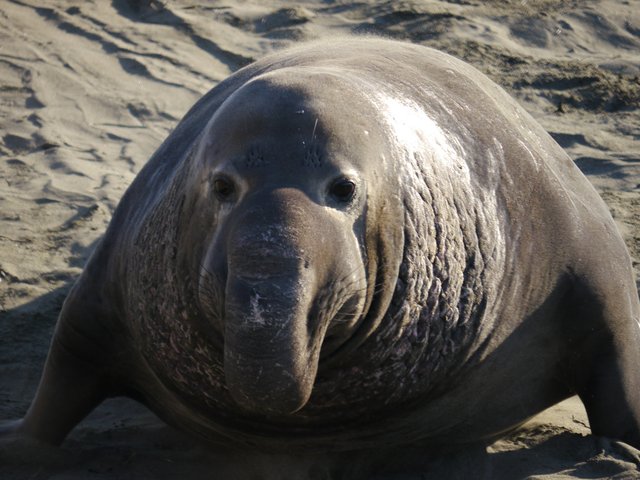
Not long ago, I was playing with the kids in the waves at a beach when an animal’s head popped up in the water. Seeing seals is fairly common along this coastline, but most are either sea lions or harbor seals. This time, I was surprised to see a gigantic nose on this particular beast. It looked like an elephant was swimming next to me.
I’ve seen real elephants on trips to foreign countries. I’ve even ridden a couple of them. I’ve seen elephants at zoos and animal sanctuaries. I’ve even seen elephants skydiving. But I hadn’t expected to encounter one in the cold waters of the north Pacific Ocean.
No, that skydiving video is not real; it’s a clever animation. And of course, it wasn’t an elephant I saw off a North American beach, but a bull male elephant seal with a humongous nose.
Northern Elephant Seals
If you’ve never seen an elephant seal, you might wonder why these pinnipeds ended up with such a strange name. But the instant you see a bull male, it all makes sense. Elephant seals have big, gray bodies and the males also feature a large, distinctive, and bulbous nose. There are northern and southern varieties; in my region we get the northerners.
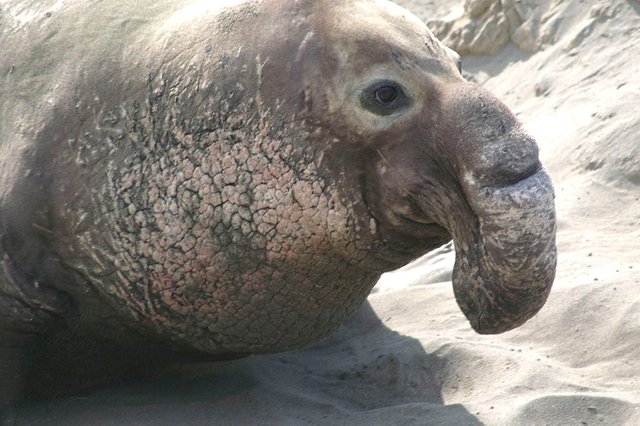
Top image and this one are both from Wikimedia.com under a Creative Commons license. Top image by Amit Patel and this one by Jerry Kirkhart.
Northern elephant seals can be seen throughout much of the North Pacific Ocean, especially off the coast of North America. But females and males alike return to a common base: one of the breeding colonies on the continent’s west coast. Ano Nuevo and San Simeon, both on California’s central coast, have the two largest breeding colonies for elephant seals.
Deep Divers
Elephant seals (northern and southern) dive much more deeply than other seals. In fact, aside from the cetacean (whale) family, elephant seals can go more deeply than any other mammal. Their average dive depth is around 2,000 feet (around 600 meters). So an average elephant seal dive doubles what a human being could achieve with the most extreme freedive. But that’s not even the elephant seal maximum; they can go as low as around 5500 feet or 1678 meters, holding their breath for as long as two hours. The human breathing record is just over 22 minutes, while 10 minutes might be more typical for freedivers.
The following is a chart created from an elephant seal with a GPS collar; each of these small curves represents one of her dives and the red portions show when her jaws were moving (probably eating). You can see that most of her food comes on deeper dives.
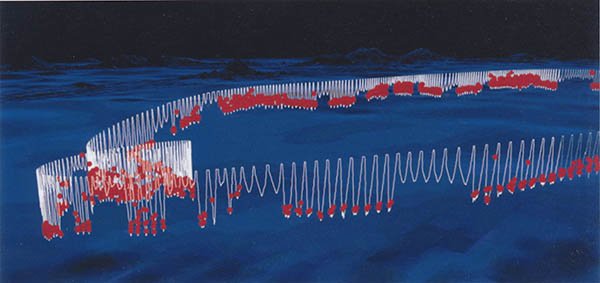
From elephantseal.org.
These seals hang around the surface for 3-5 minutes at a time, breathing and resting before their next dive. If you are fortunate enough to see one of these creatures in the water, and then they duck back down, keep watching. Mostly likely, you will see their heads again a few times before they aim for the deep. But unlike most seals and sea lions, which largely feed in relatively shallow waters, these ones head further out to make their big dives, so it’s not as common that you see their heads pop up near the coast.
Here is a chart created from tagging and tracking a group of Northern Elephant Seals, so you can see that they "commute" further north west in the Pacific, some reaching far up in Alaska or far west to the International Date Line, and then they return to the central coast for mating/breeding/pupping/etc. This particular group returns to the same spot each year, but a larger sampling of seals from different colonies will show them returning to those places as well.
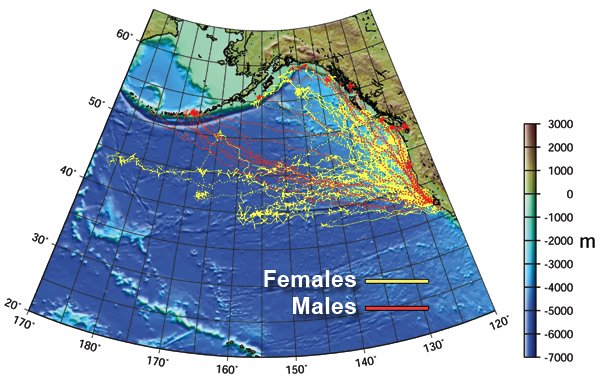
Northern Elephant Seal migration routes from Ano Nuevo. Source: UCSC.
The diet of elephant seals includes squid, octopus, sharks (though not the huge ones!), rays, salmon, and other fish. All that food packs on the pounds for these seals; like other marine mammals, they wear a thick layer of insulating fat called blubber. Adult females can reach 9-10 feet (2.7-3 meters) while adult males can exceed that with lengths of 12-18 feet (3.7-5.5 meters). The largest can tip the scales at 4400-6000 pounds (2000-2722 kilograms). On land, they look fat and clumsy, but at sea, they are sleek torpedoes moving through the water.
Elephant seals on the coastline at Vandenberg Air Force Base in central California. Public domain.
Their Population and Cycle
From Alaska to Mexico, northern elephant seals were hunted almost to extinction. The main attraction was not their coat, but their blubber, a rich source of oil that was highly prized in the 19th Century. By 1910, fewer than 1,000 elephant seals remained in these waters. Mexico was the first country in the region to address the problem by imposing a ban on hunting these animals. The United States and others followed.
Today, there are estimated to be 150,000 Northern elephants seals. Around the 1970s, they began to return or establish breeding colonies along the West Coast. The two largest are at Ano Nuevo and Piedras Blancas (a few miles north of San Simeon) in California. If you visit either of these places, you can see some elephant seals year-round. But if you go between November and February, you will see the seals preparing for their mating season. This is the most entertaining time because the large males fight with one another over the female seals who lounge on the rocks and sandy strips of beach. The fights are quite loud and can get bloody.
Here is a short National Geographic video showing the males fighting.
From December to March, females arrive to give birth to young seal pups and they are fun to see also. Pups are about 60 pounds at birth and they grow quickly. Within a few weeks after giving birth, females mate again. Then they leave their growing pups, usually by March or April, and go back to the ocean until the cycle repeats. During other months, you will see some seals at the rookery. Seals stay on land during molting (as their coats change); juveniles and elderly seals also spend more time there over the summer.
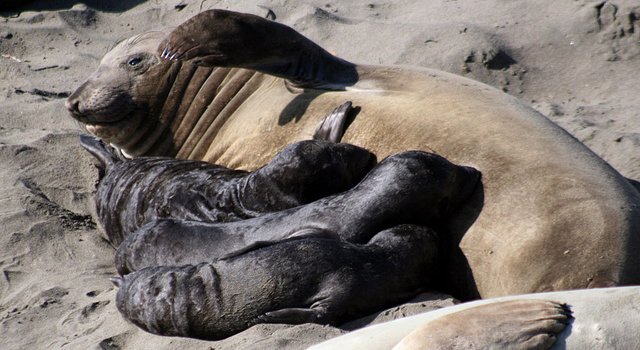
As you can see, the females and pups do not have the huge noses of the adult males. They look much like other seals. Creative Commons via Wikipedia.com by Brocken Inaglory.
Do real elephants swim in the ocean?
Of course, it’s not impossible to see a real elephant swimming in the ocean. In Sri Lanka in 2017, after a flood, two Navy ships found an elephant swimming 10 miles (16 kilometers) off the coast. Here is a video of their rescue. There’s also a video of an elephant who likes to swim in the ocean with its human friends.
Next time I’m out in the waves, I’ll start looking for snorkel and periscope tops; they might just be the tip of an elephant’s trunk!
Sea rescue of an elephant:
An elephant who likes to swim at sea:
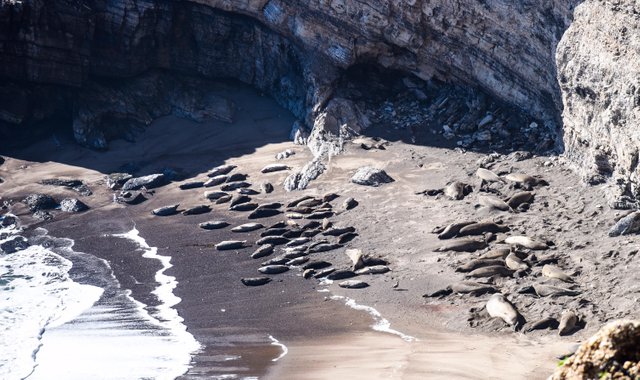
Elephants don't swim in ocean, they are majorly terrestial animal, they survive on land, they occupy or probably let me dominate an area part per thousand .
You have a great tour @donkeypong, there are so many animals both on land and oceans which are yet to be recognized.
Thanks for sharing this here, its very useful @donkeypong
The videos I included there show they can swim at sea, but it's certainly not their natural environment. The seals are an entirely different kind of animal with a similar name due to their noses.
Absolutely
If I was swimming and one of those popped up next to me I am not sure I wouldn't shit my pants,
Ah, and they fight with trucks also! When they pop up in the ocean, you just see part of their heads. Tip of the iceberg, apparently.
Dear sir, when I read your post thought you are joking about seal elephant but when i read all then thought it's really a name seal elephant that never heard before. Really it's an amazing animal looks like a baby elephant specially its nose exactly elephant's trunk. Thanks to share an amazing animal, lot's of things learn about this and all time learning different things from your post for this feeling proud to following you.
Thanks and glad you liked it.
We highlighted an incident with sea Elephant
'Elephant horse went to the floor ...'. The story of this proverb was going to happen in the island of Sri Lanka. The navy members rescued two elephants lying in the sea. After a long time, the elephants struggling to save lives in the deep sea were able to shore them.
Sri Lankan Navy said that two old elephants fluttered in a shallow lake crossing a shallow lake. They are about a kilometer away from the coast. At the time, he was trying hard to save his life.
Two of the elephants suffering from acute trouble breathing. Fortunately, a naval patrol team at that time saw the incident. The other members fell into the rescue operation with few ships, speedboats, ropes.
After long efforts, the two of the elephants were safely tied to the shore with tied ropes and proper instructions. Later they were released in the jungle.
This is not the first time that the elephants in Sri Lanka are flooded. An elephant floating eight kilometers away from Sri Lanka's coast of Indian Ocean two weeks ago.
I think if I was on the naval ship and saw an elephant swimming by, I'd probably head down to see the doctor. LOL
I'm surprised how deep they are able to dive and that they predominantly feed under deep water. I've often wondered what the purpose is behind the male's bulbous nose too. This is chock full of information! #til
Unfortunately, I don't know the answer to that one either. The big noses seem rather impractical (as opposed to on elephants, where the long trunks are very useful).
I'm just throwing something nutty out, but wouldn't it be neat if it actually housed a water to air kind of filtration system so they could stay under water longer? I mean, why not, right? Air breathing fish exist. :P
I'm sure militaries have spent a lot of time and money trying to make gill-breathing work for people.
I had never even heard of these animals before. I was lucky enough to check out quite a few sea lions and seals when I was in San Diego. If I would have seen one of these then, I would have been convinced it was just some kind of mutation. Then I would have blamed it on Mr. Burns and his nuclear power plant. Thanks for educating me today!
I love that you included the video of the animated animals skydiving, trampolining, and swimming. Good luck answering all of the comments from people who don't get that its not real ;)
Glad you saw some seals and sea lions; they're fun to watch also. Either I made flying & diving elephants real or I put doubts into peoples' minds about whether seals exist at all. Makes me shake my head and not want to try any jokes or double entendres (without a GIANT DISCLAIMER, PRINTED IN BOLD ABOUT THREE TIMES). But in the end, it's all fun. :)
Seals are clearly fake news. They are a creation of the mainstream media to distract us from the true danger posed by penguins.
interesting to note that real elephants can also swim very well. I think elephant seals are among the few species we still have left that are thriving and are no where being endangered. They provide a variety for most of the giant predators of the ocean.
Lol let's see what you dig up next time hanging around in the ocean. for me, I'll love a good old lost treasure chest
Next time I'm out there, I'll look for a treasure chest for you.
Incredible research.
Is the elephant seals a different species from the elephant found in the forest?
I have never thought about seeing an elephant doing a deep dive like 5500 feet depth like that, not even on Nat Geo Wild. But steemit schooled me about that, it is just full of information and incredible research. Well done, I will DMR and see you soon.
Very different species if you read closely. :)
Definitely, I will give it another read then. And do a research as well. Although, I should have known that but since they were both elephants... Lip sealed
Wow so we have an almost extinct type of seal called the elephant seal? I see now why it's nearly gone into extinction the oil source which it tends to offer isn't it?
These are specially unique, the females are quite very different too I wonder, I've watched documentaries and never seen this kinda seals, but if you're to suggest @donkeypong what's the best way to keep this unique creatures from totally going into extinction?
You only read part of it. The population has rebounded greatly since going nearly extinct in around 1900. Lots of them out there now.
This is good sir and as usual, always something to learn from your posts. I have never seen this creature before, except for movies and TVs. I really hope to see Penguins one day, it would delight me so much and i hope to see this one too. Really a blessing for you to encounter this at the sea sir...i can imagine the delight sir. Well done sir.
Somewhere in the southern hemisphere, you should be able to see both. I've seen pictures of southern elephant seals with penguins at the same locations. Haven't taken the time to research the locations though.
Wow! This is super cool sir and yes, i think i will do just that; research. I really hope to be so lucky to see both. I would make a post about it all week hahahaha. It would be a miracle to see it from this side